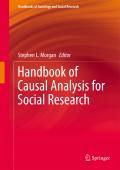
Nonlinear probability models, such as logits and probits for binary dependent variables, the ordered logit and ordered probit for ordinal dependent variables and the multinomial logit, together with log-linear models for contingency tables, have become widely used by social scientists in the past 30 years. In this chapter, we show that the identification and estimation of causal effects using these models present severe challenges, over and above those usually encountered in identifying causal effects in a linear setting. These challenges are derived from the lack of separate identification of the mean and variance in these models. We show their impact in experimental and observational studies, and we investigate the problems that arise in the use of standard approaches to the causal analysis of nonexperimental data, such as propensity scores, instrumental variables, and control functions. Naive use of these approaches with nonlinear probability models will yield biased estimates of causal effects, though the estimates will be a lower bound of the true causal effect and will have the correct sign. We show that the technique ofY-standardization brings the parameters of nonlinear probability models on a scale that we can meaningfully interpret but cannot measure. Other techniques, such as average partial effects, can yield causal effects on the probability scale, but, in this case, the linear probability model provides a simple and effective alternative.